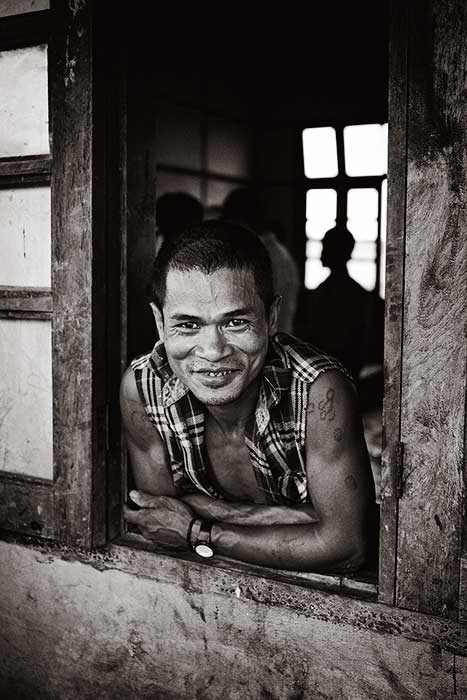
As mentioned in a post a few weeks back (Happy National Day), my wife (Laura) and I recently visited Myanmar. A significant amount of our time there was spent visiting villages in the Irrawaddy Delta that were badly hit by Cyclone Nargis last year. We spent time listening to the life stories of the villagers, checking out the progress of rebuilding work, sharing God’s love and having a time of prayer and fellowship with them. Here are some facts about Cyclone Nargis with some photos I took during our visit:-
Cyclone Nargis swept across the Irrawaddy Delta and southern Yangon, the former capital, on the evening of May 2, 2008 with winds of 240 kph (150 mph).
.jpg)
Nearly 140,000 people died and 2.4 million were severely affected. The cyclone was the worst to hit Asia since 1991, when 143,000 people died in Bangladesh. It was the worst natural disaster to hit Asia since the 2004 tsunami that killed at least 232,000 people. Most of those who died were killed by a 3.5 metre wall of water that hit the low-lying Irrawaddy Delta. We visited the township of Bogalay (southwest of Yangon) together with the villages in its vicinity. An estimated 10,000 people had perished there.
.jpg)
Damage caused by the Cyclone was estimated at US$4 billion. Some 42 percent of food stocks were destroyed. The Irrawaddy Delta, an area covering some 23,500 square kilometres, is known as the country’s rice bowl and home to about 7.35 million people. The cyclone flooded paddy fields with sea water, damaged irrigation systems and destroyed seed supplies. Of 1.3 million ha (3.2 million acres) of rice fields in the cyclone-hit areas, 60 percent was affected by the Cyclone. A year later when we visited, the yield of rice was just 10% of the normal yield compared to before Cyclone Nargis hit. Many of the villages we visited are still in need of rice and many families are surviving on 1 meal a day which is a meagre bowl of rice soup that barely fills their stomachs.
.jpg)
.jpg)
Cyclone Nargis killed around 200,000 farm animals, including 120,000 used by farmers to plough their fields. Less than 10 percent of small animals and poultry essential for many landless farmers have been replaced. The villages that we visited had received some ducklings to replace a fraction of the ones killed during the cyclone. These ducklings were purchased from donations made through the organization which my wife, Laura serves in, for the rebuilding phase of the villages affected by the Cyclone.
.jpg)
.jpg)
Only 17,000 out of 375,000 destroyed houses have been rebuilt. Aid groups estimate at least 500,000 survivors, including 200,000 children, are living in makeshift shelters, primarily due to a lack of funding. An estimated 200,000 fishing boats were destroyed by Cyclone Nargis. Like the ducklings, many families also received fishing boats purchased from donations made through the organization Laura serves in.
.jpg)
.jpg)
During our visit, we caught merely a small glimpse of the many needs of the people. One year after the cyclone, the needs are still many! My strongest memories of this trip will be the hospitality and kindness of the people who sought to serve and bless us as visitors with the little that they had. Many of the faces of the people have also made a deep impression on my mind. If you would like to help in the rebuilding projects or find out more, drop me a note (Contact Me).
I’ll end with a few more photos. The first photo shows the feet of Laura (centre) and the feet of 2 villagers who assisted her in negotiating the muddy and slippery paths of one of the villages we visited. They walked beside her everywhere she went, one on each side, holding her arms to keep her balanced and on the less muddy area of the paths. The villagers also took it upon themselves to wash our feet each time it became muddy from walking from place to place. In a culture where it is considered taboo to touch another’s feet because the feet are considered the lowest (spiritually as well as physically) part of the body, having them wash our feet was a most humbling experience. In fact, the villagers even wanted initially to piggyback us as they did not want us to dirty our feet!
.jpg)
We also learnt that many villagers had waited hours; some even half a day, just to see us for a brief moment and show their gratitude for the help rendered to them in the past year. Sixty people squashed in the host’s hut with many others spilling outside was not uncommon and yet no complaints were made. It didn’t matter that they didn’t speak English. All they wanted to say was thank you, thank you and thank you. Laura shared with them that they had bestowed on us the greatest gift of time when we were not even dignitaries. We were overwhelmed that they would count us worthwhile to be with for such a short time. Time is truly an invaluable gift that is sparingly given in more developed countries.
.jpg)
.jpg)
.jpg)

.jpg)

.jpg)
